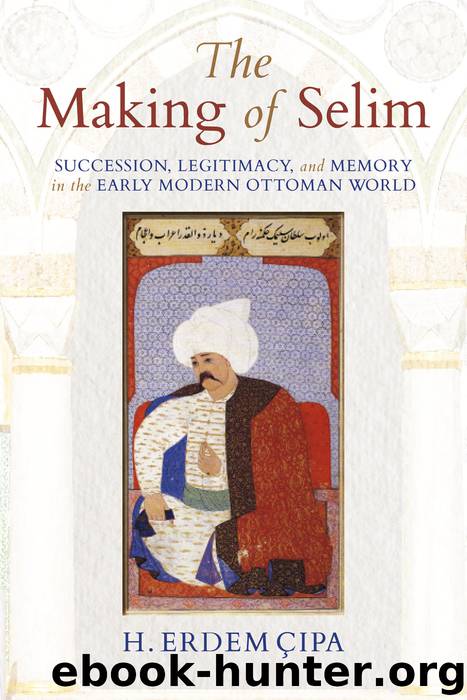The Making of Selim by Cipa H. Erdem;

Author:Cipa, H. Erdem;
Language: eng
Format: epub
Publisher: Indiana University Press
Published: 2017-04-16T04:00:00+00:00
Conclusion
“THE PAST IS NEVER DEAD. It’s not even past,” wrote William Faulkner.1 For early modern Ottomans, memories of Selīm were neither dead nor part of a long-forgotten past but rather were an integral component of an “eternal present,” constructed at numerous historical junctures by literate men and women of diverse sociocultural backgrounds with disparate—and at times conflicting—political and ideological viewpoints.2
These memories were by no means uniform. Writing in the Süleymānic age, Mevlānā ʿĪsā (fl. 1530s) recalled Selīm’s reign as an era of peace, when “the sheep and the wolf strolled together without fighting [and] the mouse placed its head on the paw of the cat.”3 Yet the same era evoked painful memories for a “servant girl” (ḳul ḳızı) from the provincial town of Bergama, whose petitions are preserved in the imperial archives at Topkapı Palace. In these petitions, the writer explains that she was commissioned by Selīm to travel alone from town to town, with valuable goods in her possession, to test the orderly nature of Ottoman society (niẓām-ı ʿālem). She laments that she was assaulted, robbed, and molested by several men on a number of occasions. She states that during one of these instances an attacker knocked out one of her teeth. She complains that these acts of violence were so brutal that she suffered a miscarriage. Last but not least, she expresses grief that local authorities honored neither the sultanic writ nor the royal servant who accompanied her. Instead, they mocked her. More significantly, they mocked Selīm’s authority as embodied in his imperial prescript.4
As these two accounts demonstrate, Ottoman authors who remembered Selīm and his reign did so in their own, subjective “eternal present.” Their acts of memory-making did not necessarily belong to different historical periods. In fact, both Mevlānā ʿĪsā and the “servant girl” wrote within a decade of Selīm’s death, suggesting that the variance in their memories resulted from factors other than chronology.5 There is no doubt that each author’s “eternal present”—and, by extension, memory—was shaped by his or her individual experiences, expectations, and agendas. In turn, the genres in which Ottoman writers recorded these memories influenced the collective memory of future generations of Ottoman readers. Whereas Mevlānā ʿĪsā included his recollection of the state of affairs during Selīm’s reign in a versified historical-eschatological treatise, the “servant girl” recorded her painful personal experiences in a petition addressed to Selīm’s son, Süleymān. Whereas Mevlānā ʿĪsā remembered Selīm’s sultanate as an era of justice that ushered in the Süleymānic age, the ḳul ḳızı of Bergama recalled the pain she endured for Selīm’s experiment. Whereas Mevlānā ʿĪsā employed literary tropes—replete with sheep and wolves, cats and mice—to emphasize the enduring peace, the “servant girl” narrated with brutal honesty the blow that knocked out her tooth and the beating that caused her to suffer a miscarriage. Finally, Mevlānā ʿĪsā’s goal was to highlight the undisturbed natural order of things during the Selīmian era, as a prelude to the Süleymānic age, whereas that of the ḳul ḳızı was simply to plead for justice and compensation.
Download
This site does not store any files on its server. We only index and link to content provided by other sites. Please contact the content providers to delete copyright contents if any and email us, we'll remove relevant links or contents immediately.
| Africa | Americas |
| Arctic & Antarctica | Asia |
| Australia & Oceania | Europe |
| Middle East | Russia |
| United States | World |
| Ancient Civilizations | Military |
| Historical Study & Educational Resources |
Empire of the Sikhs by Patwant Singh(22767)
The Wind in My Hair by Masih Alinejad(4843)
The Templars by Dan Jones(4558)
Rise and Kill First by Ronen Bergman(4545)
The Rape of Nanking by Iris Chang(4023)
12 Strong by Doug Stanton(3419)
Blood and Sand by Alex Von Tunzelmann(3055)
The History of Jihad: From Muhammad to ISIS by Spencer Robert(2505)
Babylon's Ark by Lawrence Anthony(2431)
The Turkish Psychedelic Explosion by Daniel Spicer(2245)
Gideon's Spies: The Secret History of the Mossad by Gordon Thomas(2235)
No Room for Small Dreams by Shimon Peres(2235)
Inside the Middle East by Avi Melamed(2230)
Arabs by Eugene Rogan(2193)
The First Muslim The Story of Muhammad by Lesley Hazleton(2154)
Bus on Jaffa Road by Mike Kelly(2035)
Come, Tell Me How You Live by Mallowan Agatha Christie(2025)
Kabul 1841-42: Battle Story by Edmund Yorke(1921)
1453 by Roger Crowley(1880)
